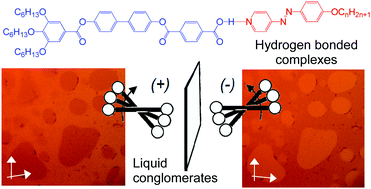Mirror symmetry breaking in cubic phases and isotropic liquids driven by hydrogen bonding†
Abstract
Achiral supramolecular hydrogen bonded complexes between rod-like 4-(4-alkoxyphenylazo)pyridines and a taper shaped 4-substituted benzoic acid form achiral (Ia![[3 with combining macron]](https://www.rsc.org/images/entities/char_0033_0304.gif) d) and chiral “Im
d) and chiral “Im![[3 with combining macron]](https://www.rsc.org/images/entities/char_0033_0304.gif) m-type” bicontinuous cubic (I432) phases and a chiral isotropic liquid mesophase (Iso1[*]). The chiral phases, resulting from spontaneous mirror symmetry breaking, represent conglomerates of macroscopic chiral domains eventually leading to uniform chirality.
m-type” bicontinuous cubic (I432) phases and a chiral isotropic liquid mesophase (Iso1[*]). The chiral phases, resulting from spontaneous mirror symmetry breaking, represent conglomerates of macroscopic chiral domains eventually leading to uniform chirality.

- This article is part of the themed collection: Chirality at the nanoscale


 Please wait while we load your content...
Please wait while we load your content...